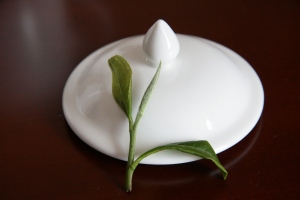Perhaps no other tea steeping vessels that we sell generate as many questions as our Chinese gaiwans and Japanese houhins.
These small, glazed, handle-less porcelain vessels are often mistaken for something meant for children. Many tea drinkers cannot imagine using such a small vessel to steep their tea. And, admittedly, they bear little resemblance to the traditional notion of ‘teapot’.
So when we explain how these tea vessels work and why they are important – no, iconic – in their respective tea cultures, quite often tea enthusiasts realize that they too might benefit from using one of these to steep certain teas.
Both gaiwams and houhins perform the same function as a teapot – but their small size is designed to accommodate the ratio of tea leaf to water that is necessary when steeping and re-steeping certain types of tea. For gaiwans, these are oolong, Pu-erh and other Heicha; and for houhins it is the needle-thin leaves of Sencha and Gyokuro
Gaiwans are useful tools, and can be used to steep both the most costly or modestly priced tea. Gaiwans are perfectly acceptable in the best teahouses. While one can spend hundreds of dollars on an un-glazed Yixing clay teapot which will ‘influence’ the flavor of the tea steeped in it, a gaiwan is commonly used in China for steeping those same teas. In fact, some tea enthusiasts prefer gaiwans that are made from glazed porcelain which imparts no influence on the flavor of the tea.
A Japanese houhin is just right for one or two servings when one is looking for just a little ‘taste’ of tea or when steeping tea that is particularly costly. Japan, too, produces wonderful glazed and unglazed teapots – such as our selection of Japanese teapots from Tokoname – that are expensive and the construction of which sometimes influences the flavor of the tea steeped in it. But for practicality and effectiveness of use, a houhin is a great choice.
As with Chinese teas, the serving size of tea is small but the flavor of the tea liquor is rich in dimension and full in the mouth because more leaf and less water has been used. And the leaf is steeped several times, showing a different facet of flavor with each re-steeping.
For some, learning to use a gaiwan is tricky business – it is a one-handed operation and requires a bit of dexterity to become comfortable using it. There is no strainer and no handle – when the tea has steeped and is ready to be poured out, just cock back the lid, grab the gaiwan by the top edge, place the knuckle of your first finger securely on the top of the lid to hold it in place and pour out the tea into a small pitcher …without allowing tea leaves to exit with the tea liquor.
Conversely, a houhin has a lid, a fine strainer built into the nose of the teapot, and a pouring lip. You place your fingers along side of it and rest your hand on the top of the lid to keep it securely in place. This is easier for some to manuver than a gaiwan and a houhin can also be used to successfully steep Chinese oolong, Pu-erh and other Heicha; whereas a gaiwan does not work very well with fine leaf Japanese green teas.
Whichever you choose, these are versatile and simple vessels which are a PERFECT and REASONABLY INEXPENSIVE way to steep many Asian teas as they would be steeped in China, Japan, or Hong Kong.
Shop our selectiom of Gaiwans and Houhins














